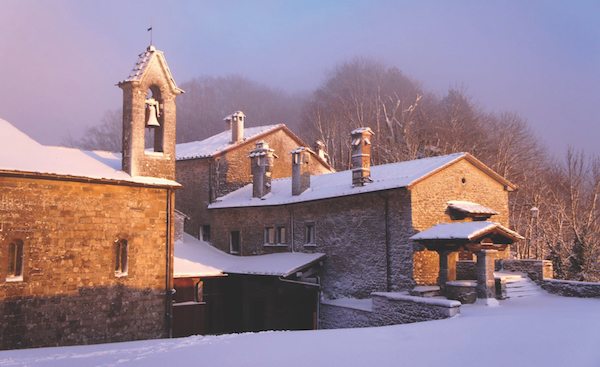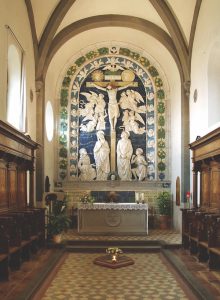Rachael Martin shares the story behind this religious site, which is nestled in the hills of Tuscany’s beautiful Casentino National Park

In Canto 11 of Paradiso, the third and final book of his Divine Comedy, Dante speaks of that “harsh rock between Tiber and Arno where he received from Christ the last seal, which his limbs bore for two years”. The “he” Dante speaks of is St Francis of Assisi, and the “last seal” are the stigmata that St Francis received. The harsh rock is the crag on which the Sanctuary of La Verna is built, high up in the Casentino on Mount Penna, a sheer drop from which you overlook the beautiful natural landscapes that the area has to offer.
This is where St Francis of Assisi went in summer 1224 and where he asked God to let him experience the Passion of Christ. His prayers were answered not only spiritually but also physically in the form of the famous stigmata he received while there; five stigmata for the five wounds of Christ. La Verna was declared a sacred place and a church was built. The site is marked nowadays with the Chapel of the Stigmata that was built in 1263, and by a plaque to show the exact spot.

The cycle of 21 modern frescoes along the Corridor of the Stigmata leading to the Chapel of the Stigmata show scenes from St Francis’ life and in particular of his time spent at the sanctuary, where you can also visit the stone slab upon which St Francis used to sleep, now covered by an iron grill. The chapel contains the famous Crucifixion relief by Andrea della Robbia, and there other reliefs detailing the life of Christ in the Basilica. There’s a museum too that details the life of the monks through documents and old bibles, and gives a real insight into how the monks lived. Look out for the cross by Giovanni Angelo Montorsoli and ceramic bust by Andrea della Robbia.
The friars who live there in the sanctuary today welcome people who wish to visit the monastery or who wish to take part in the life of the community through prayer and/or by staying there on a retreat. They also sell products made by the friars such as liqueurs, ointments and creams, infusions and sweets.
Full details can be found at the La Verna website.
When to visit
Obviously the sanctuary does get busy, and if you visit on a bank holiday you may not fully be able to appreciate the true atmosphere the place can convey. Wherever possible, do try to organise your schedule to ensure you can visit on any other day, especially if you have spiritual reasons for visiting.
Otherwise, the Feast of the Stigmata is the sanctuary’s important religious festival that takes place on 17 September. It’s popular with pilgrims and especially with young people who take part in a special vigil that they hold the night before. The Feast of San Francesco takes place every 4 October, the date of his death in 1226. He was made a saint two years later in July 1228. On the 18th of July 1939 Pope Pius XXII declared him the patron saint of Italy, “the most Italian of saints, and the most saintly of Italians”.
If you’re planning to travel to this part of Tuscany, Rachael’s Head for the hills article is a great companion for your trip.
